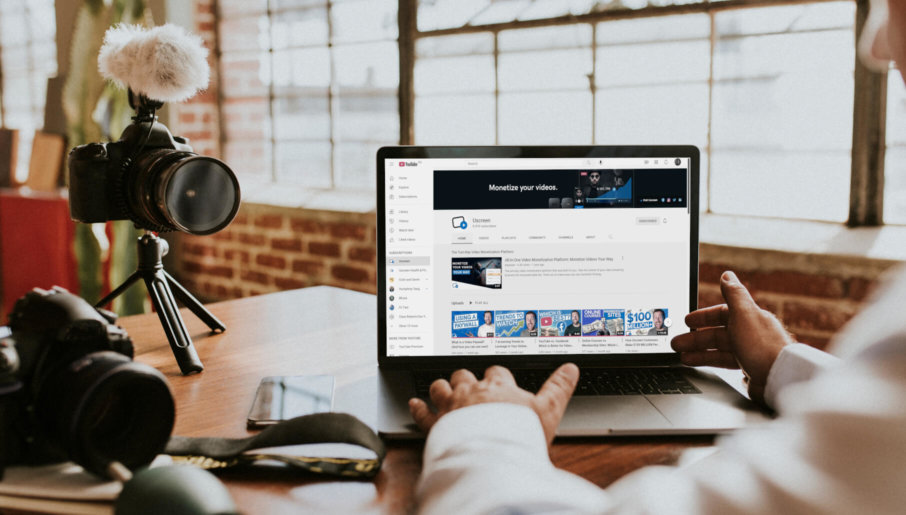Many YouTubers who start a membership site wonder what to do with their YouTube channel. If you’re reading this, you might be wondering too.
It might seem like you have two choices:
- Let your channel die (what a waste!)
- Continue to monetize it (but then what’s the point of your new membership?)
But, there is a third (and best) option:
- Use your YouTube momentum to drive business to your new membership business!
With this option, you can create a steady stream of potential leads who are already engaged with your videos.
This article shows you how to repurpose your YouTube channel into a powerful membership site conversion engine.
Understanding the YouTube to membership marketing funnel
You might feel a little stuck on what to do with your YouTube channel because you think YouTube is a direct competitor to your new membershipservice.
But, that’s not true; your YouTube channel and your membership are 2 different platforms that play different roles in your business.
YouTube is not a video monetization platform – it’s a video search engine.
Think of it this way:
- Your membership is your video monetization platform. It’s where you sell and stream your video content.
- Your YouTube channel is your video marketing platform. It’s where you get your membership business discovered and grow your brand awareness.
Creating a membership doesn’t make your YouTube channel obsolete. You’ll still need YouTube to:
- Generate traffic and funnel to your membership.
- Build brand awareness in your niche.
- Connect the right people to your paid membership.
This makes your YouTube channel a powerful digital marketing asset.
How to make a funnel on YouTube step by step
There are 6 simple steps you need to follow to turn your YouTube channel into a marketing engine that’ll complement your sales funnel and grow your membership:
- Create a landing page for your membership
- Switch to a “Search Engine” mindset
- Adopt the YouTube Marketing Funnel
- Get clear on your YouTube content structure
- Optimize your existing content
- Create targeted content for your new marketing funnel
1. Set up a landing page for your membership
Start by setting up a landing page. Your landing page is a designated page on your membership that you can link to in your video descriptions and bio to send your most engaged viewers to.
The purpose of this page is to:
- Give you an easy-to-use page you can drive high-converting traffic to.
- Share the benefits of using your premium membership website.
- Convert your YouTube leads into paying customers.
Take a look at CarpFix’s landing page, for example:
See how they use their landing page – built using Uscreen’s landing page builder – to showcase their membrship. Their page includes:
- Clear branding and messaging.
- A short written explanation of what CarpFix does.
- A trailer with all the information visitors need to know about CarpFix’s membership.
- Content catalog examples.
- A FAQ snippet.
- Pricing plans.
- Calls to action (CTA).
This makes their landing page comprehensive and engaging, which will entice potential customers and empower them to make an informed decision!
Make sure to include in your page:
- The name and logo of your membership, (which we recommend be consistent with your YouTube channel’s branding.
- A catchy tagline.
- A free trial sign up button.
- The benefits of subscribing to your membership.
- An FAQ section.
- Preview of your content catalog.
- Subscription prices for different plans and what’s included in each plan.
If you’re a Uscreen customer, you can access the landing page builder from your dashboard:
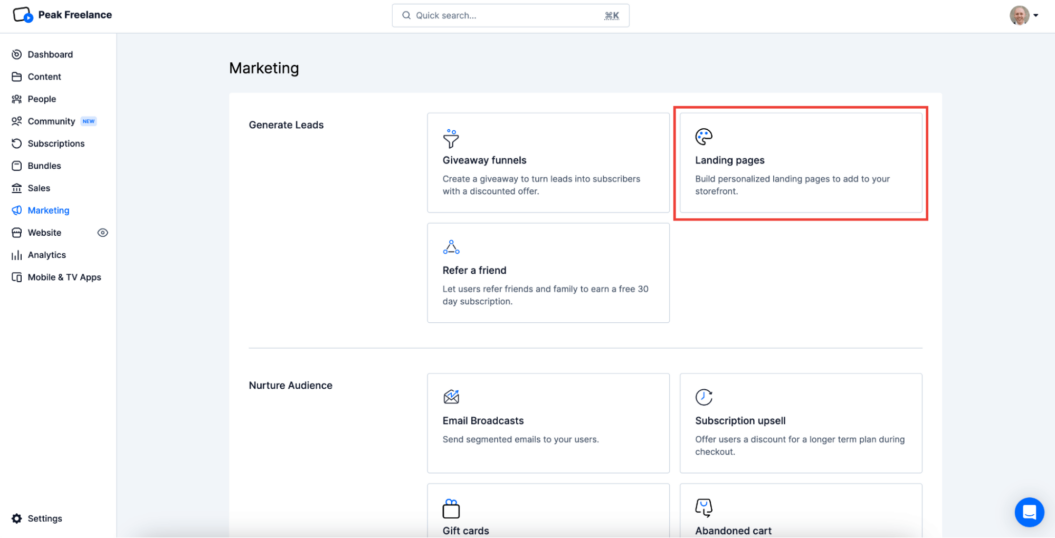
Better still, we have a variety of premade templates you can use to structure your page and customize them to fit your brand.
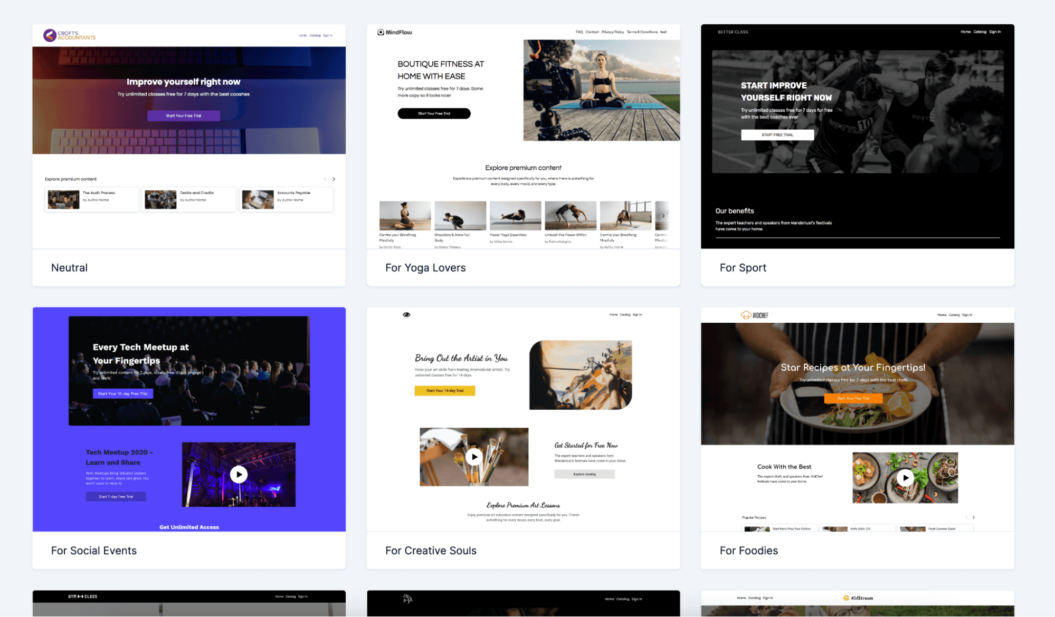
It’s up to you whether you choose to create a separate landing page or use your homepage. What matters is linking to your membership site on your YouTube videos!
Now that you have a clear path to your membership, let’s get into what you’ll need to do to your YouTube channel to turn it into your best marketing engine.
2. Switch to a “Search Engine” mindset
The next step is a switch in how you think about using YouTube. You’ll have to start using YouTube for what it is: the world’s largest video search engine.
Everything you post on YouTube from now on needs to have a clear goal to connect with a well-defined demographic that will feed back into your membership business in one way or another.
We know – this may sound intimidating. It was intimidating to us too, until we designed what we like to call a YouTube to Membership Marketing Funnel.
We’ll get into the nitty-gritty of how you do this over the next few steps. But, for now, be prepared to approach your YouTube content in a much different way.
💡 KEY TAKEAWAY: YouTube is not a reliable monetization platform. Start looking at it as a video marketing channel.
3. Adopt The YouTube Marketing Funnel
The next step is to understand and adopt the YouTube Marketing Funnel.
A marketing funnel (generally) is a way of looking at the buyer journey from top to bottom—from when a potential customer becomes aware of your brand to when they place their order (and possibly, beyond). This journey has stages, which is often metaphorically represented as a funnel.
A YouTube Marketing Funnel is specifically focused on the customer journey from YouTube to your membership business. This YouTube Marketing Funnel is split into 3 stages:
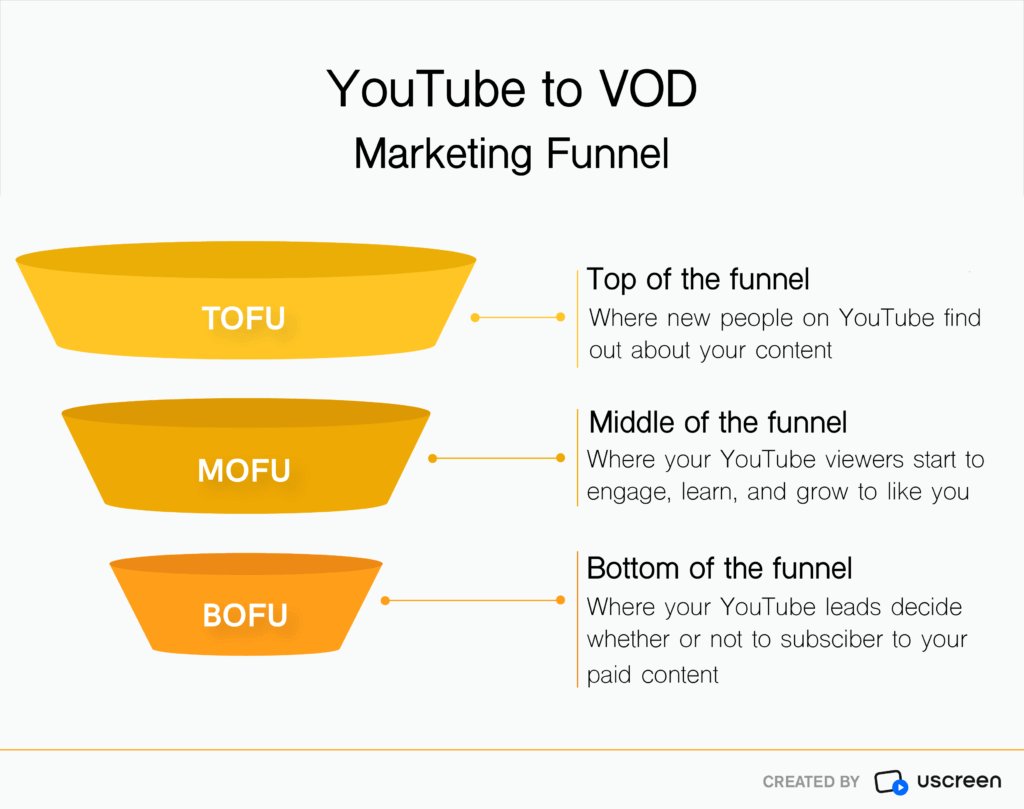
The main goal here is to push your target audience from the very top of the funnel to the very bottom, all the way to being paying subscribers to your membership site.
Let’s take a closer look at each of these stages and how to create the right types of videos for each of them.
Top Of The Funnel: Where your brand meets potential customers
The top of the funnel is where new people come to first find out about your content. It’s the “point of entry” for those people looking for the kind of content you’re creating.
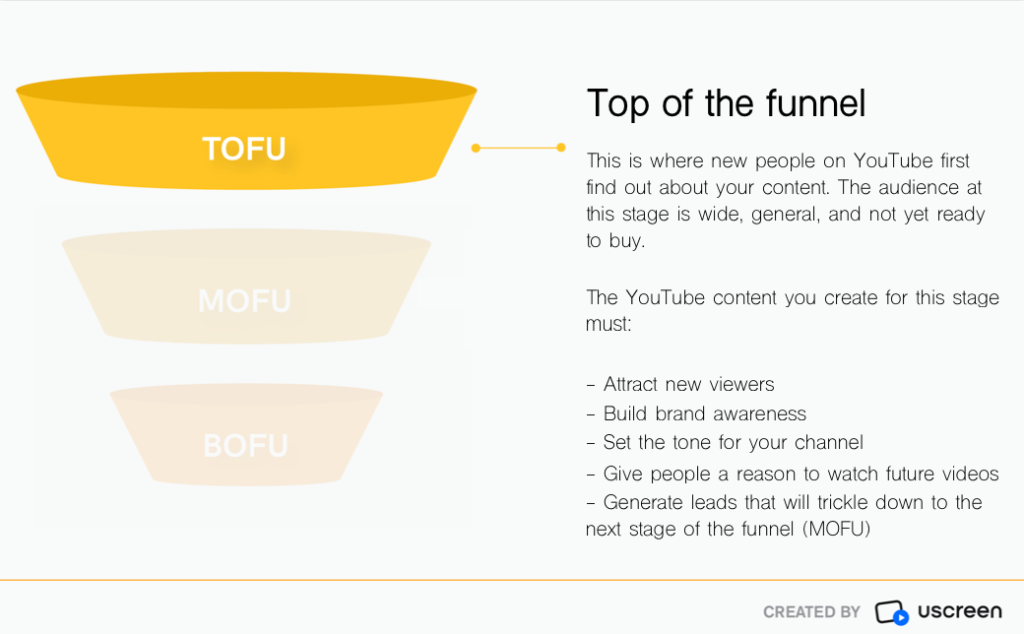
The audience at this stage of the marketing funnel is wide, general, and not yet ready to buy.
💡 KEY TAKEAWAY: Your main marketing goal for the TOFU stage is to get the right people hooked on your channel, so much so that they take themselves to the next stage of the marketing funnel.
You can achieve this goal by creating TOFU YouTube content that:
- Attracts new viewers.
- Builds brand awareness.
- Sets the tone for your channel.
- Gives people a reason to watch future videos (this can look like helping them solve a problem or educating them on a relevant topic).
- Generates leads that will trickle down to the next stage of the funnel (MOFU).
It’s the online equivalent of walking to a physical store for the first time; you’re looking to subconsciously answer the questions:
- Did I find what I was looking for?
- Did I feel good about what I saw?
- Would I come back for more?
The content you create for the TOFU stage of the YouTube Marketing Funnel will fall into one of these types:
- Video listicles.
- Topical vlogs.
- Opinion pieces.
- Simple tutorials.
- Entertaining content.
Let’s take a closer look at each of these types of TOFU YouTube content.
Video listicles
A video listicle is a video that uses a list as its thematic structure but is fleshed out with sufficient information for every point.
Example: 7 Ways to Promote YouTube Videos
This type of content is easy to digest, quickly touches on lots of different points, and allows viewers to easily dip in and out.
Brian Dean uses this to great effect on his SEO-focused YouTube channel. He uses list-based content to share tips his audience can instantly put to use:
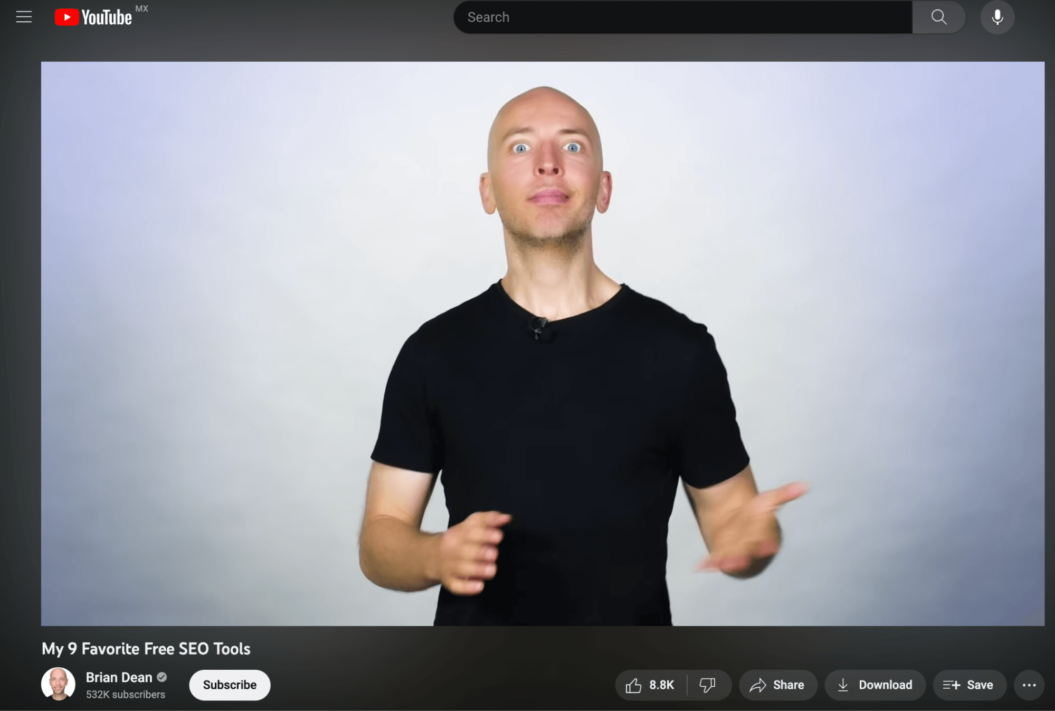
This style of video is also:
- Highly shareable.
- Great for starting discussions.
Both of which can help grow your brand.
Topical vlogs
Topical vlogs can help you set the tone for your channel.
By choosing a sought-after topic in your niche, or one that’s currently in the news, you can really set out your stall on what you think.
Let’s take a look at Humphrey Yang, a personal finance, investing, and entrepreneurship YouTuber. He picks topics that people always talk about and creates interesting vlogs about them.
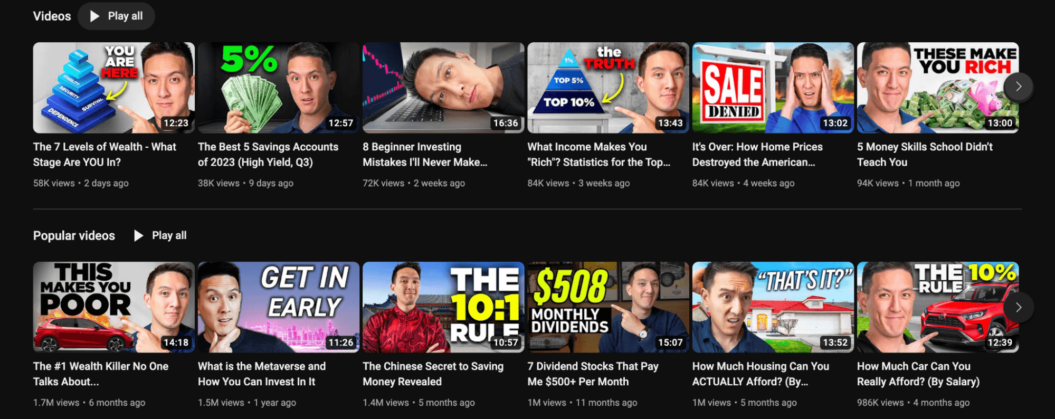
If you watch any video you can see that Humphrey dissects the popular myths behind personal finance and shares actionable advice for people (usually investing beginners) who want to make money off. Perfect for TOFU audiences.
These online videos can be as simple as grabbing your camera and sharing your thoughts, or you can get creative and turn them into actionable takeaway posts.
Opinion pieces
Opinion pieces aim to take a basic topic and share thoughts, feelings, and emotions about them. They are more targeted and less takeaway-focused than the vlogs in the last section.
Colin and Samir, digital storytelling YouTubers, are a great example of this. Take a look at their take on how Logan Paul changed the boxing industry:
This video provides some cool insights into the history and development of mainstream and YouTube boxing and why they think Logan Paul ‘sort of’ changed the face of the industry.
While Logan Paul’s debut in the professional ring was definitely an ‘in’ topic, the opinions you share don’t need to be hot takes on a newsworthy subject. Instead, they just need to be relevant to your niche and the people you want to attract.
Tutorial and explainer videos
One of the most important parts of the YouTube Marketing Funnel is search traffic.
These are viewers who find your videos because they’re looking for an answer to a question, a solution to a problem, or advice on how to do something.
By creating simple, easy-to-follow, tutorials you can lure people to your content and hook them for your future updates.
Here’s a really cool example from Art For Kids Hub:
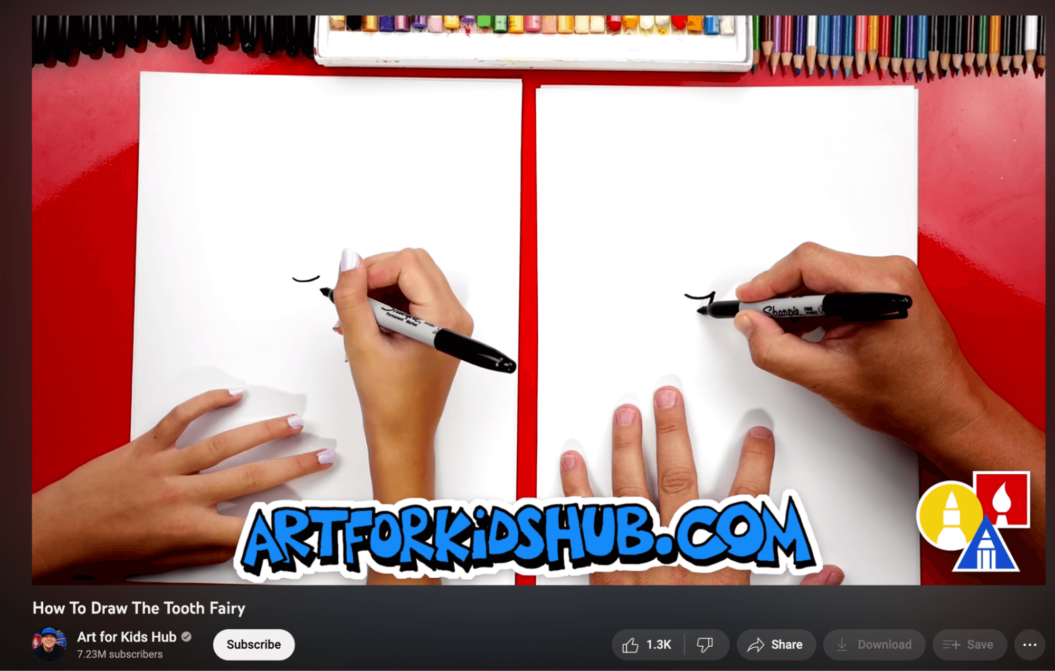
This type of content ideally provides a lot of value to the viewer, positioning your brand as reliable and helpful in a specific niche. But, these tutorials aren’t valuable enough to go into your premium membership product.
Entertaining content
The final type of content is also one of the most common – entertaining content.
These are videos that showcase what your channel (or brand) is about, and serve no other purpose than to be interesting, entertaining, and maybe shareable.
BFUNK, a dance choreography-focused channel, does this by sharing the routines instructors have put together for Bollywood and Bhangra songs:
Pay attention to how it entertains and hooks viewers with the “wow factor” of this content. The thing to remember about all these pieces of content is that they are designed to get the right people to the next stage of the funnel.
Which brings us squarely to the middle of the funnel.
Middle Of The Funnel: Where you spark interest for paid content
The middle of the funnel is where people begin to engage with your content, form concrete opinions about your brand, and join your community.
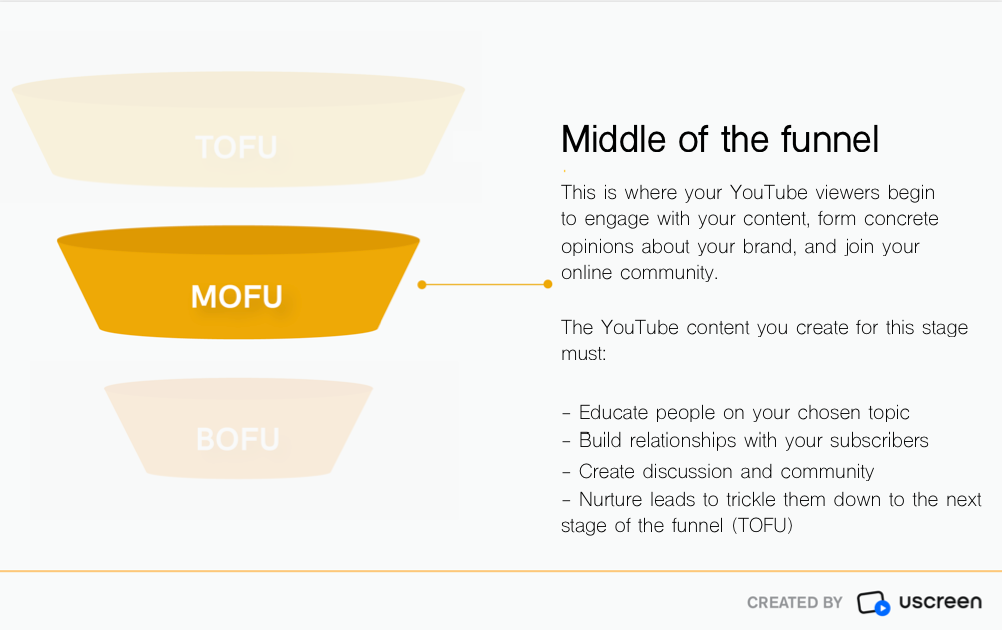
People at the MOFU stage are definitely interested in your content niche and what you’re creating, but aren’t quite ready to pay for your content just yet.
However, your content, paid and unpaid, is definitely on their radar.
💡 KEY TAKEAWAY: Your main marketing goal for the MOFU stage is to keep people hooked on your content and convince them to move to the next stage of the funnel.
Let’s hold on to the BFUNK example for a little while longer…
BFUNK’s core community is formed of die-hard dance fanatics. The video we shared earlier was about choreography for a song called Kangna Tera Ni, and showcased a number of dancers performing it.
People who were watching for pure entertainment would be happy to leave the video there. But, what about the people who want to learn the dance?
Well, BFUNK has a premium video for that. At the end of their video BFUNK showcases clips of people learning the dance in the studio. They also link to their membership site’s landing page in the description, to direct their most interested viewers to the full tutorial.
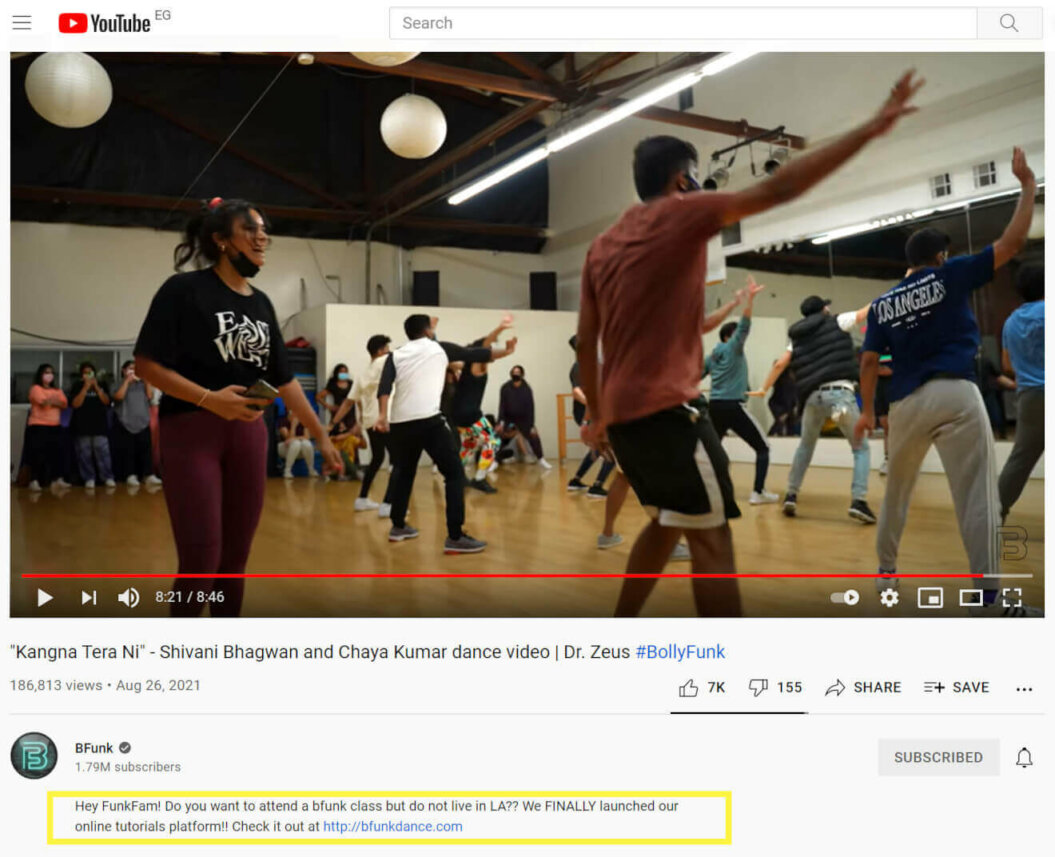
Better still, if these viewers aren’t ready to start their free trial or pay for a subscription, BFUNK has a number of short dance tutorials on their YouTube channel:
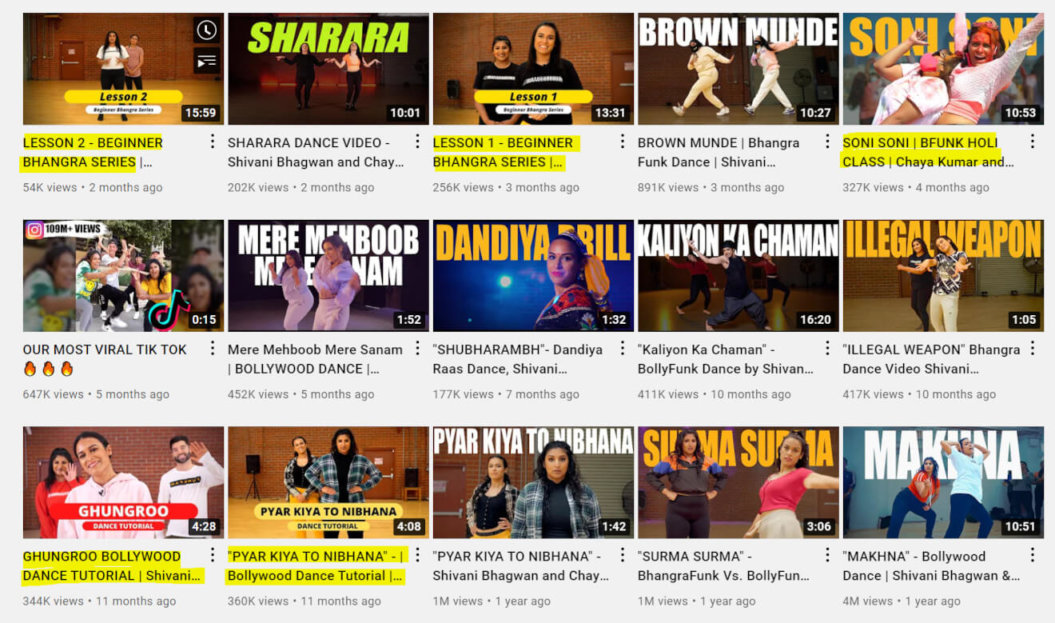
This is when you start to see the YouTube Marketing Funnel in motion, as these engaged viewers are progressed to the middle of the funnel.
You can achieve this by creating MOFU YouTube content that:
- Educates people on your chosen topic.
- Builds relationships with your subscribers.
- Creates discussion and community.
- Gives viewers a taste of what your paid content can do for them.
- Nurtures leads and trickles them down to the next stage of the funnel (TOFU).
This means MOFU content will likely fall into one of these two types of content:
- Tutorials.
- Breakdowns.
Let’s take a closer look at each…
Tutorials / educational videos
Tutorials look at one element your audience wants to learn about and breaks it down.
If you have an information-focused video business you might be thinking, “why would I give a tutorial away for free?”
The answer is two-fold:
- Viewers will still pay for content they can get for free.
- You can limit the “depth” of the tutorial as much as you want in length, knowledge, or both. (Just as you would when you repurpose paid content for social media marketing.)
BFUNK’s tutorial videos like this one…
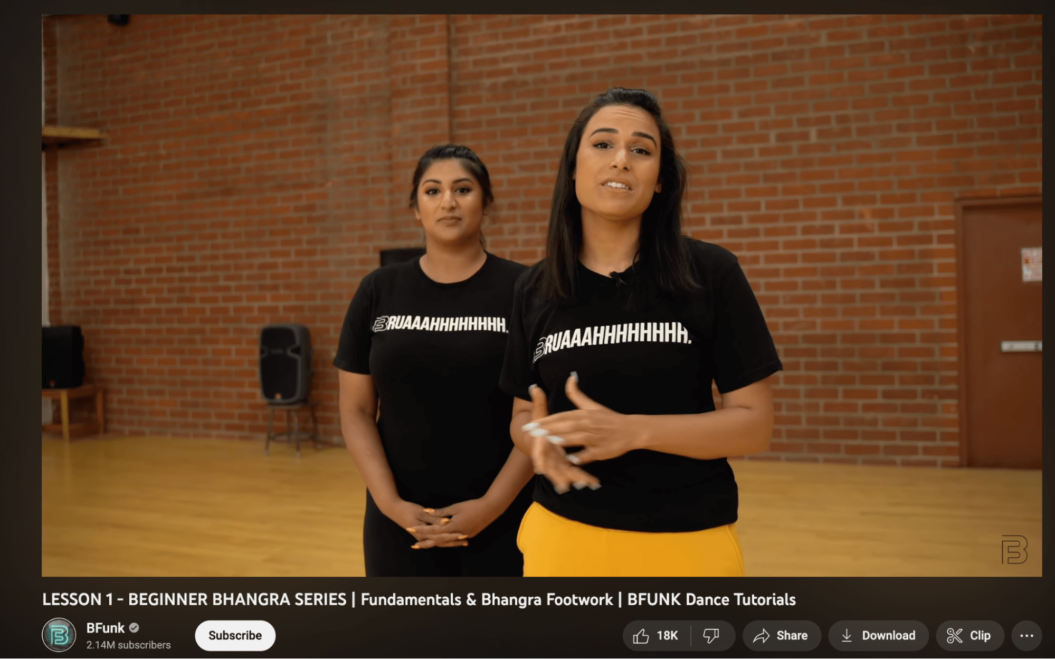
… are good examples of MOFU tutorial content for YouTube.
Breakdowns
Breakdowns look to explore a topic in-depth and impart valuable knowledge to the reader. These types of content are perfect for establishing yourself as an authority and thought-leader in your niche.
Practice with Clara, a yoga entrepreneur, does this in a really creative and brilliant way. After she hosts a live stream class she leaves around 5 minutes at the end of the class for a live Q&A that are focused on specific yoga techniques.
Breakdowns have the power to spark discussion between members of your audience and with you as the creator, and can garner thousands, if not more, views!
The key with MOFU content is to engage your existing viewers, present your membership as a potential upgrade, and entice people to the next stage of the funnel.
This is called lead nurturing.Practice with Clara provides content that introduces their premium platform. When you get to the end of the video, you can see a call-to-action (CTA) to the channel’s private membership service.
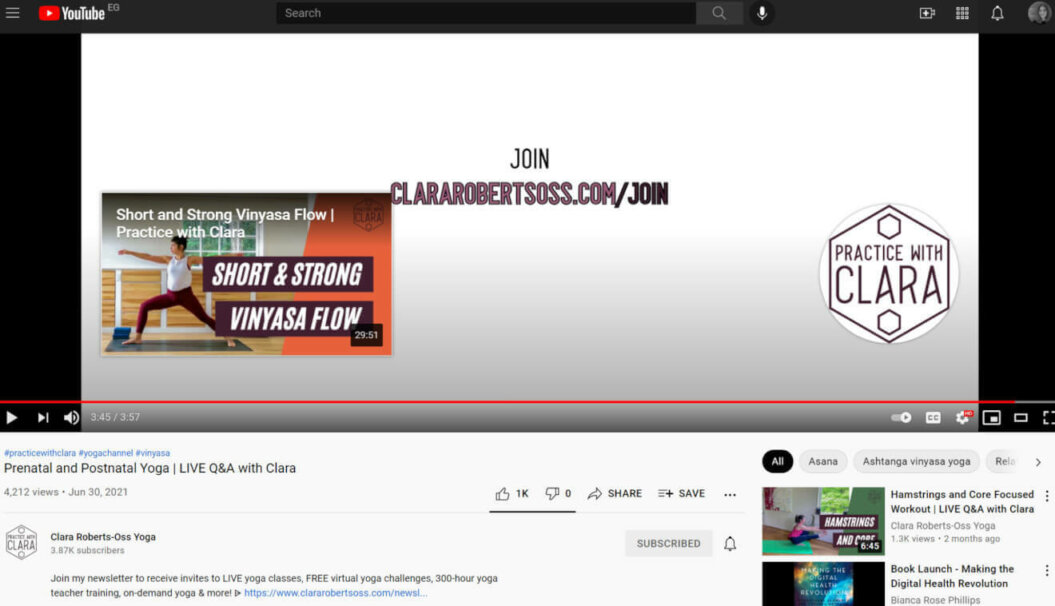
Each of the video types explained above has:
- High levels of value to the reader.
- Strong hints to their premium offering.
- Calls to action to move to the next stage of the marketing funnel (BOFU).
Bringing us to the next and final stage of the YouTube Marketing Funnel.
Bottom Of The Funnel: Where viewers become customers
The bottom of the funnel is where you promote your membership business and convince people to try your premium paid content.
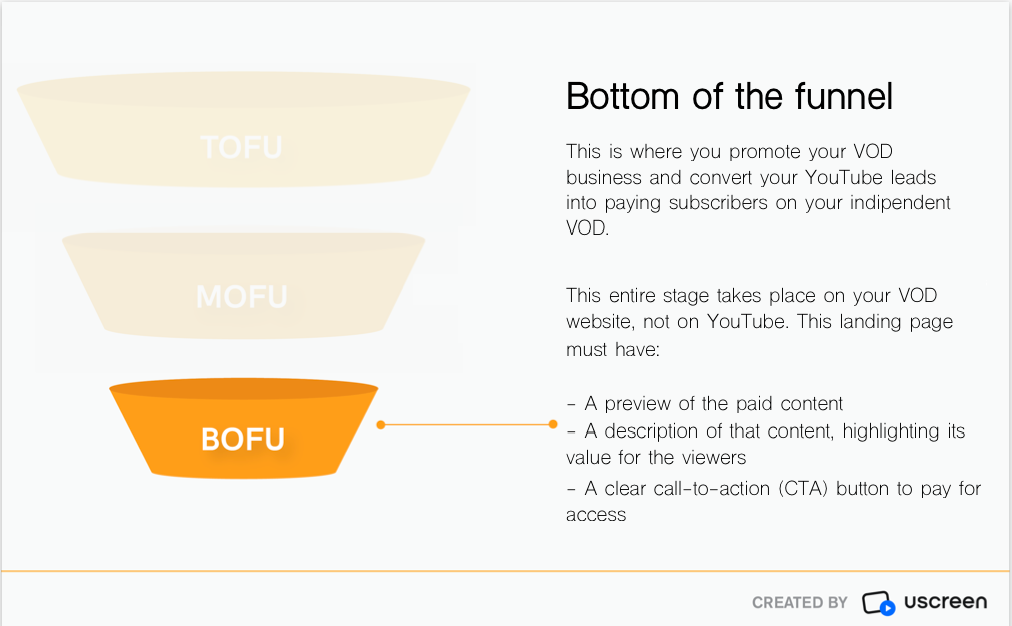
Viewers at this stage of your marketing funnel are ready to buy and are weighing up their options; they’re just waiting for a little nudge from you to get them over the edge.
This entire stage takes place on your membership website, not on YouTube. That’s why having a landing page with social proof is so important!
BOFU content is the next logical step from your MOFU content. Viewers will have followed a strong CTA at the end of your videos, clicked on your landing page, and found themselves on your membership site.
💡 KEY TAKEAWAY: Your main marketing goal for the BOFU stage is to seal the deal. You’ve gotten your leads so far down the funnel with free content, all you have to do now is convince them that this paid offer is right for them.
Let’s look at that process a little closer.As mentioned above, BFUNK’s MOFU content contains a CTA to access the full tutorial that you can see in the last portion of their video. The link in the video’s description then takes you to their content catalog:
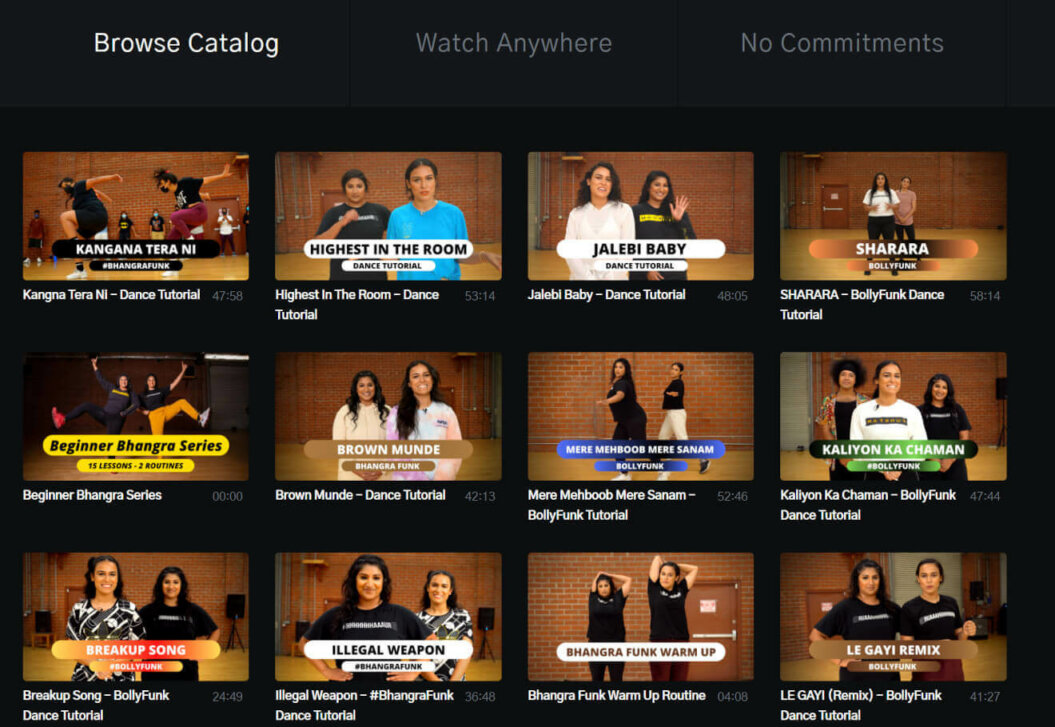
That’s BOFU content. You can see that BFUNK has:
- A shorter version of the tutorial which acts as a teaser for their premium content.
- A description of the lesson.
- A CTA that directs viewers to your membership landing page.
This is a simple and effective way to convert your quality leads, that made it all the way down your funnel, to take the next step and become subscribers to your membership site.
You can also look to use different types of content, that may work better for your business, such as:
- Trailers.
- Previews.
- Product Videos.
- Video sales letters.
- Written sales letters.
- Customer testimonials.
- Free trials!
When we looked at Uscreen’s 1.1 million subscribers we found that free trials converted viewers to paying subscribers at 52%.
So, if you want to increase the impact of your BOFU content, look to offer a 7 to 10-day free trial for viewers to test your membership platform. It can also help improve retention metrics. If members are happy with their experience during the trial, they’re more inclined to become paying customers and stay for the long term.
But wait… there’s more!
The Loyalty Stage: Where you keep customers around
Now, once someone becomes a member, it doesn’t mean the story is over… it’s just beginning! This phase focuses on maintaining a relationship with members after they’ve bought your membership, keeping them engaged and satisfied.
Uscreen makes it easy to retain members in a few different ways.
Check-in with members through livestreaming
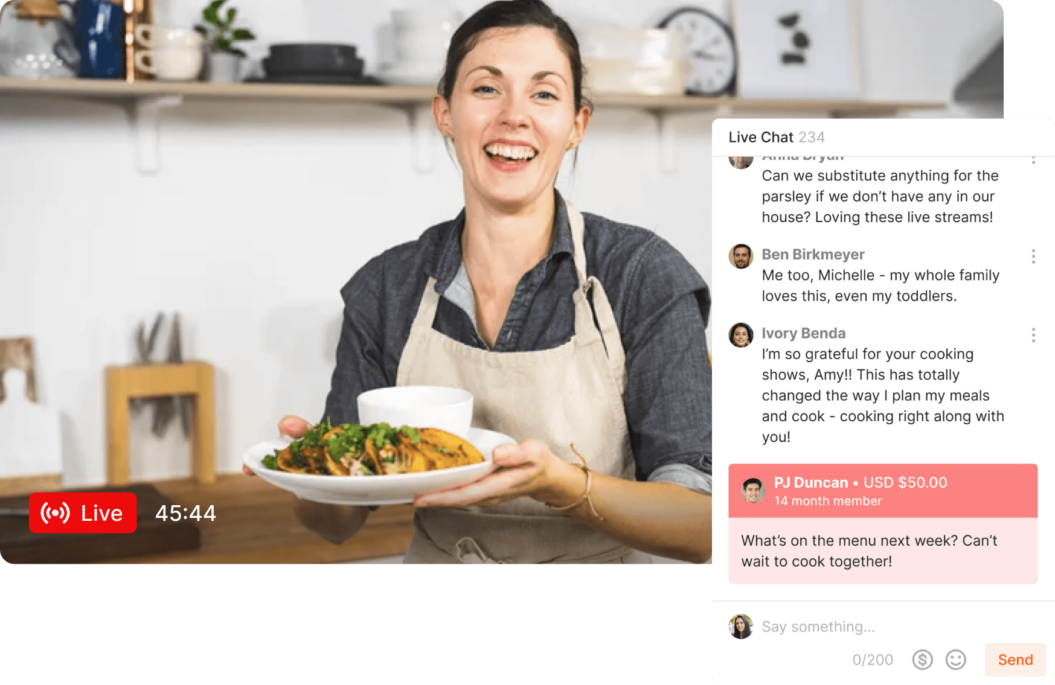
Check-ins build relationships with members. It’s easy to see members’ progress, let them ask questions, and interact with them.
Connecting with members live is another cool way to use Uscreen. Set a monthly date, and members can join the livestream from your website or membership app.
Build a community
Studies show that community is good for peoples well-being, happiness, and health. Having a community area inside your membership lets folks build bonds and interact with each other.
With Uscreen, you can let members publish and comment on posts in a Facebook-style community. You can set up a group in minutes in your dashboard under the Community tab.
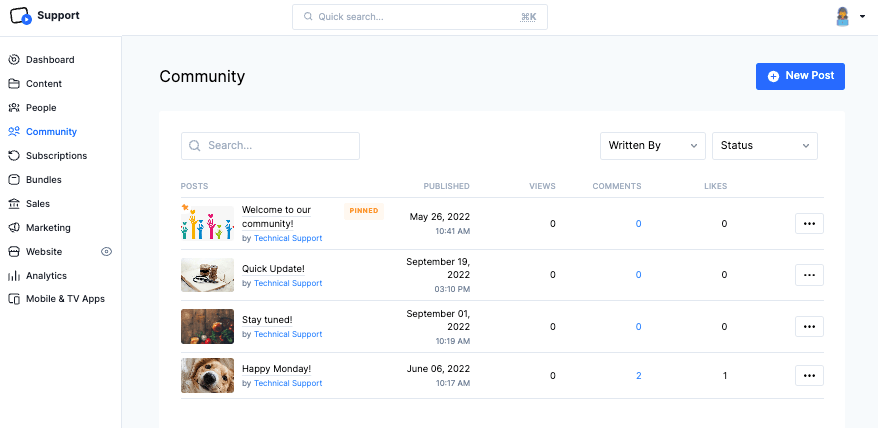
Automate renewals
Renewing memberships automatically reduces hassle for members and boosts revenue for your company.
You can create membership plans with recurring billing options, such as monthly, quarterly, or yearly. Then, make auto-renewal the default option. This eliminates the need to manually renew memberships for members.
Time and money are valuable assets for members, so you should respect them. Send automated email reminders before the renewal date. Uscreen makes this easy.
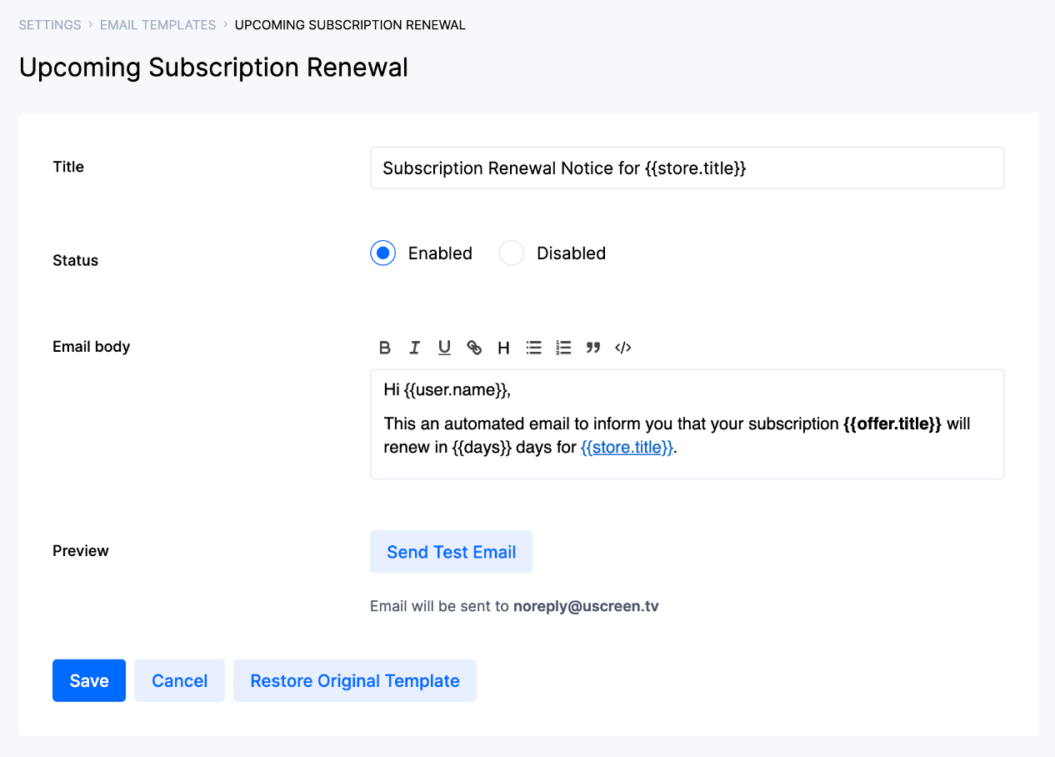
In your dashboard, click Settings, then Email Templates. There is a template called “Upcoming Subscription Renewal” that is sent around 30 days before a member’s subscription ends. Tweak the copy to match your brand.
For more ways to keep members around (and increase upsells), read 9 Proven Membership Retention Strategies From the Pros on the blog.
4. Get clear on your YouTube content structure
By now you should have a clear idea of how your YouTube content needs to be structured.
Each video needs to:
- Have a clear purpose.
- Appeal to a section of your YouTube Marketing Funnel.
- Direct viewers to your membership’s landing page.
It’s important that you think of each YouTube video you create as part of a larger marketing strategy. You should be able to answer these questions:
- What is the goal of this video?
- Who does it appeal to?
- Where does it fit into my membership marketing funnel?
Better still, you’ll be able to link specific videos into “chains” that correspond to each stage of the marketing funnel. This will help you progressively lead the viewer towards your membership landing page that is made to convert them to start their free trial or pay for your service!
We recommend that you split your YouTube content up like this:
- TOFU content – 60%
- MOFU content – 40%
This split lets you focus on lead generation and can help you to gather data on what content attracts the correct people to your marketing funnel.
You should also include:
- Calls to action (i.e. subscribing to your channel, checking out your membership site, liking the video).
- Links to other content (like a podcast or Instagram profile).
- Links to your membership landing page.
- Branded intros and outros.
These ensure that everything is connected and has a purpose on your YouTube channel. But, before you create any new content, let’s look at how you can get the most out of your existing content.
5. Optimize your existing content
In this step, you’re going to take a close look at your existing YouTube content.
You’ll want to look at each of your videos and decide whether they are:
- TOFU content.
- MOFU content.
- BOFU content.
Then see how you can optimize them to fit your new marketing approach.
Here’s how the optimization might look at each stage:
- TOFU content: keyword-driven headlines for SEO, optimized descriptions and thumbnails, landing page link in descriptions, call to action to join your mailing list.
- MOFU content: content-driven headlines, in-video cards, links to other content, join the discussions in the comments, landing page link in descriptions.
- BOFU content: product-driven headlines, strong calls to action, links to landing page, testimonials or positive user comments.
You may also find that your channel has a number of videos that drive high levels of traffic, but could also go behind your membership’s paywall.
You will need to look at the statistics for these videos and decide whether these videos are:
- Better used as premium content on your membership site (in which case, remove them from your YouTube channel, keep them exclusive on your site, and potentially create a shorter, teaser form of that video for your channel).
- More effective as “traffic magnets” on your YouTube channel (in which case, keep them as is).
Either way…
This step is critical to the process so be sure to take care of this before moving on to the next one.
6. Create new YouTube content
The final stage in this process is doing what you do best – start creating epic YouTube content.
How you do this is up to you, but remember the key points from this guide:
- Have a clearly defined purpose for each video and what purpose it serves in your funnel.
- Provide a high level of value to your viewer.
- Make sure all videos have CTAs and are connected to the next marketing funnel stage.
Include your membership landing page in your descriptions.
YouTube to Membership Case Study
Your Book of Memories (YBM), which started off generating just $380/month on YouTube, grew to $5k/month in just four months. With 17k subscribers and countless high-quality DIY videos on YouTube, the revenue didn’t reflect the effort.
YBM’s founder, Frances Long, decided to use Uscreen after exploring several membership site platforms. The goal was to turn YouTube subscribers into paying streamers and enhance the community.
The result was an 885% boost in monthly revenue without having to create any new videos. Notably, 3.7% of YBM’s YouTube subscribers switched to the paid service. Not only does the YBM YouTube channel maintain its vibrant community, but it also converts leads to premium subscribers.
Run a YouTube funnel strategy for your membership business today
Congrats! You’ve made it through this pretty intense guide.
By now you should have a clear understanding on how to transform your YouTube channel into a powerful marketing tool for your membership website.
Understand and apply each of these 6 elements and you will be well on your way to creating a YouTube Marketing Funnel that works for you.
YouTube marketing funnel FAQ
What is a marketing funnel YouTube?
A marketing funnel on YouTube is the journey potential customers take from discovering your brand to signing up for a membership. The funnel visualizes the journey from viewer to buyer.
How do you make a funnel on YouTube?
Creating a YouTube funnel starts with creating content to get people’s attention. Then, giving them more specific information to consider your membership.
Next you’ll need to provide persuasive content or calls-to-action to get them to convert, and then create loyalty content to keep them coming back. This often involves a mix of video types, including YouTube ads, tutorials, testimonials, and more.
What are the 4 stages of the marketing funnel?
- Awareness: Where potential customers first learn about a product or service.
- Consideration: Where they evaluate the product or service and its competitors.
- Decision: Where they decide whether or not to make a purchase.
- Loyalty: Where they become repeat customers or brand advocates.
